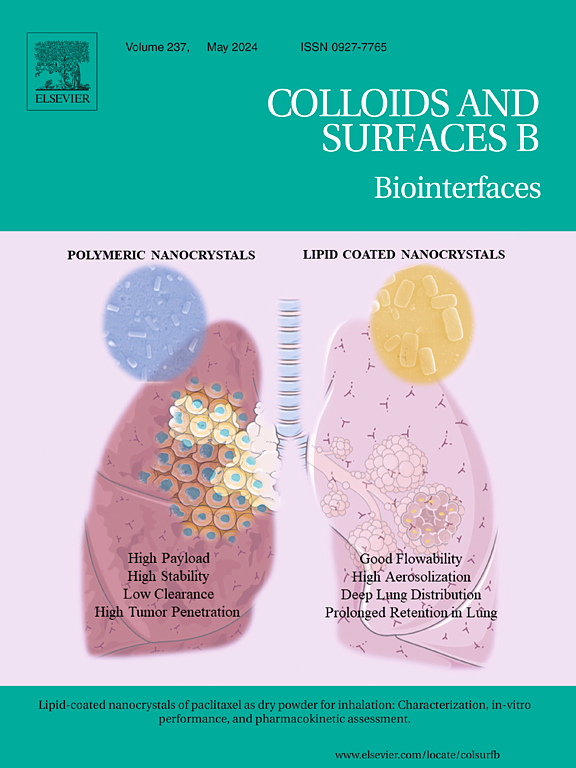Single-aggregate morphological and biomechanical detection of atherogenic aggregated low-density lipoprotein (agLDL) by atomic force microscopy
IF 5.4
2区 医学
Q1 BIOPHYSICS
引用次数: 0
Abstract
Aggregated low-density lipoprotein (agLDL) has long been regarded as an atherogenic factor and was recently supposed to play a driving force role in atherogenesis. However, the underlying mechanisms for its atherogenicity remain poorly understood. Here, agLDL was successfully induced by physical (vortexing) or biological (alpha-chymotrypsin or α-CT and sphingomyelinase or SMase, a protease and a phospholipase, respectively) methods, and verified by turbidimetry, size distribution, and relatively low-resolution morphology. Moreover, the produced agLDL had the aggregation degree-dependent atherogenic property according to macrophage lipid deposition data. Then, the single-aggregate morphological and biomechanical (stiffness and stickiness) properties of agLDL at early stages of aggregation (e.g., LDL dimer, trimer, and multimer) were detected by atomic force microscopy (AFM). Interestingly, intra-aggregate LDL of agLDL had a relatively larger average size than native LDL (i.e., LDL monomer). Most importantly, we revealed that agLDL has lower average Young's modulus and stronger average adhesion force than native LDL (i.e., agLDL is softer and stickier than native LDL). The softer and stickier properties of agLDL than native LDL probably are responsible for the atherogenicity of agLDL according to its aggregation degree-dependent atherogenic property. Targeting the biomechanical properties (e.g., stiffness and stickiness) of agLDL or other LDL derivatives may be a potential strategy for preventing atherosclerosis.
原子力显微镜对致动脉粥样硬化聚集性低密度脂蛋白(agLDL)的单聚集体形态学和生物力学检测
聚集性低密度脂蛋白(agLDL)长期以来被认为是一种动脉粥样硬化因子,最近被认为在动脉粥样硬化发生中起驱动作用。然而,其致动脉粥样硬化的潜在机制仍然知之甚少。在这里,agLDL通过物理(涡旋)或生物(α-凝乳胰蛋白酶或α-CT和鞘磷脂酶或SMase,分别是蛋白酶和磷脂酶)的方法成功诱导,并通过浊度法、大小分布和相对低分辨率的形态学进行验证。此外,根据巨噬细胞脂质沉积数据,产生的agLDL具有聚集程度依赖的动脉粥样硬化特性。然后,通过原子力显微镜(AFM)检测agLDL在聚集早期(如LDL二聚体、三聚体和多聚体)的单聚形态和生物力学(刚度和粘性)特性。有趣的是,agLDL的聚集内LDL的平均大小比天然LDL(即LDL单体)大。最重要的是,我们发现agLDL比天然LDL具有更低的平均杨氏模量和更强的平均粘附力(即agLDL比天然LDL更柔软、更粘)。根据agLDL的聚集程度依赖性的致动脉粥样硬化特性,agLDL比天然LDL更软、更粘的特性可能是其致动脉粥样硬化的原因。针对agLDL或其他LDL衍生物的生物力学特性(如硬度和粘性)可能是预防动脉粥样硬化的潜在策略。
本文章由计算机程序翻译,如有差异,请以英文原文为准。
求助全文
约1分钟内获得全文
求助全文
来源期刊

Colloids and Surfaces B: Biointerfaces
生物-材料科学:生物材料
CiteScore
11.10
自引率
3.40%
发文量
730
审稿时长
42 days
期刊介绍:
Colloids and Surfaces B: Biointerfaces is an international journal devoted to fundamental and applied research on colloid and interfacial phenomena in relation to systems of biological origin, having particular relevance to the medical, pharmaceutical, biotechnological, food and cosmetic fields.
Submissions that: (1) deal solely with biological phenomena and do not describe the physico-chemical or colloid-chemical background and/or mechanism of the phenomena, and (2) deal solely with colloid/interfacial phenomena and do not have appropriate biological content or relevance, are outside the scope of the journal and will not be considered for publication.
The journal publishes regular research papers, reviews, short communications and invited perspective articles, called BioInterface Perspectives. The BioInterface Perspective provide researchers the opportunity to review their own work, as well as provide insight into the work of others that inspired and influenced the author. Regular articles should have a maximum total length of 6,000 words. In addition, a (combined) maximum of 8 normal-sized figures and/or tables is allowed (so for instance 3 tables and 5 figures). For multiple-panel figures each set of two panels equates to one figure. Short communications should not exceed half of the above. It is required to give on the article cover page a short statistical summary of the article listing the total number of words and tables/figures.
 求助内容:
求助内容: 应助结果提醒方式:
应助结果提醒方式:


